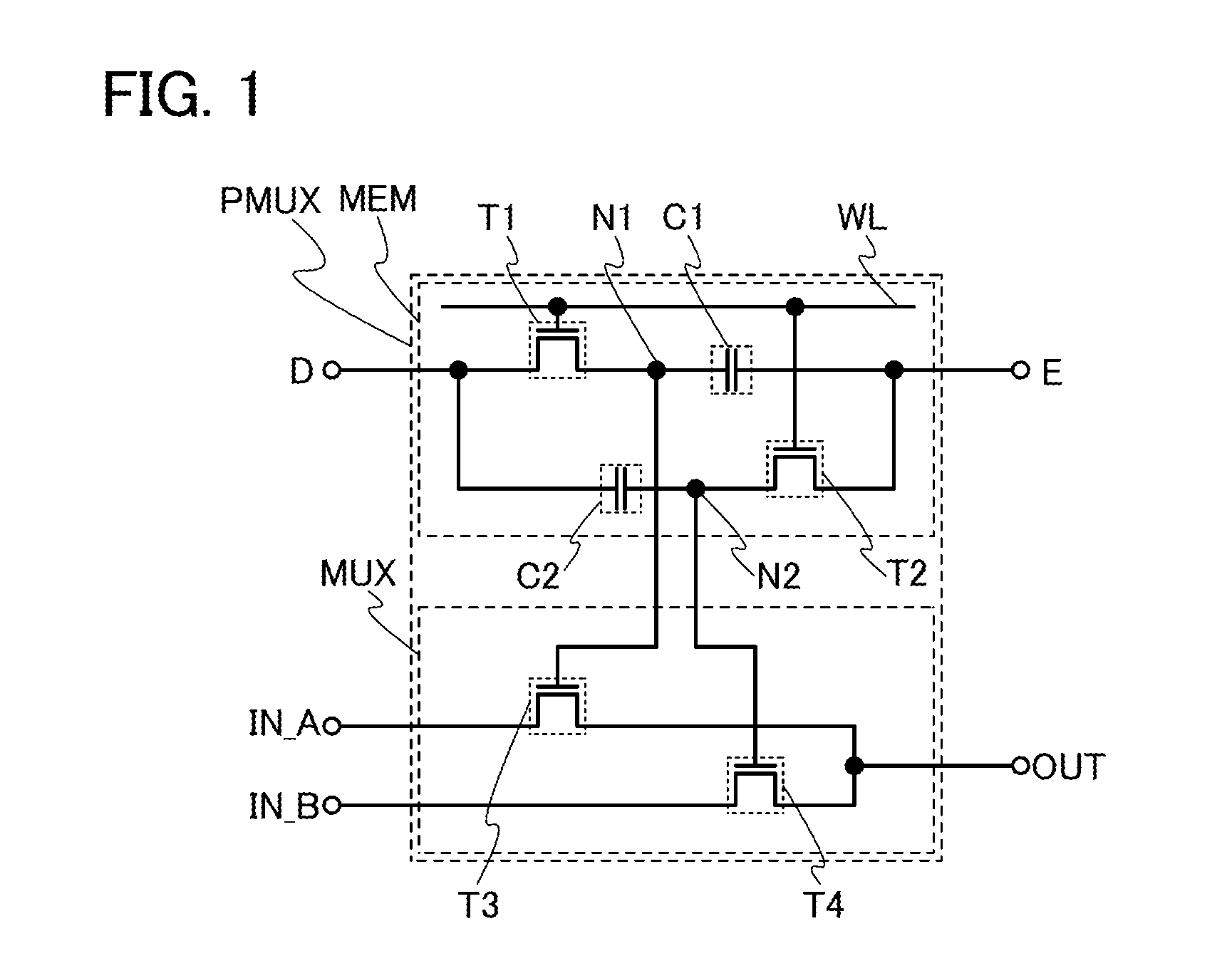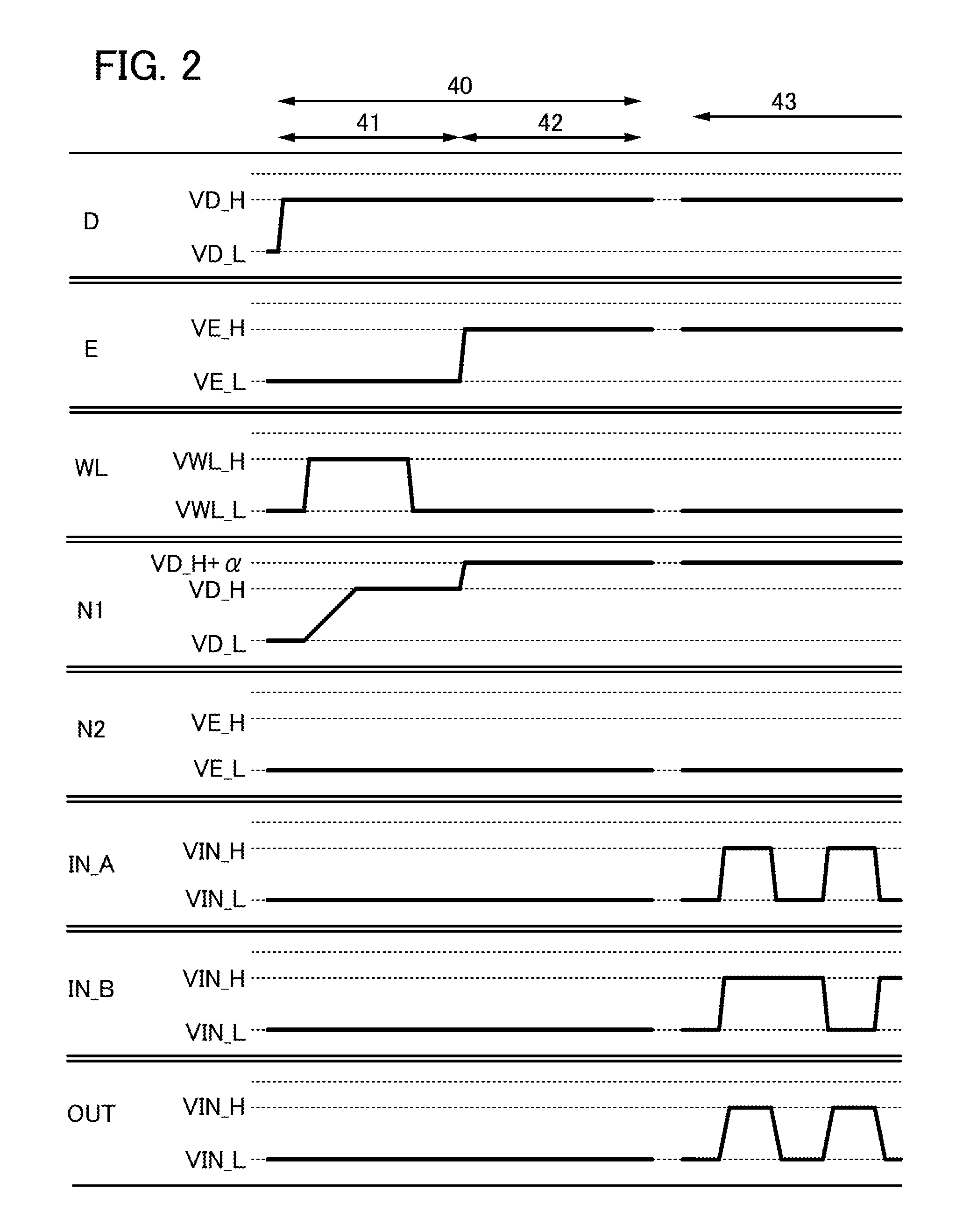Method for driving semiconductor device
a technology of semiconductor devices and driving parts, applied in the direction of power consumption reduction, pulse techniques, instruments, etc., can solve the problems of increasing power consumption in standby state, and achieve the effects of reducing power consumption, reducing starting time, and preventing power supply
- Summary
- Abstract
- Description
- Claims
- Application Information
AI Technical Summary
Benefits of technology
Problems solved by technology
Method used
Image
Examples
embodiment 1
[0043]In this embodiment, one embodiment of a semiconductor device including a selection circuit and a method for driving the semiconductor device will be described with reference to FIG. 1, FIG. 2, FIGS. 3A and 3B, and FIG. 4.
[0044]FIG. 1 is a circuit diagram of a selection circuit PMUX including a memory MEM and a multiplexer MUX.
[0045]In FIG. 1, the memory MEM includes a transistor T1, a capacitor C1, a transistor T2, and a capacitor C2.
[0046]In the transistor T1, one of a source and a drain is connected to a terminal D, the other of the source and the drain is connected to a first electrode of the capacitor C1, and a gate is connected to a word line WL. A second electrode of the capacitor C1 is connected to a terminal E.
[0047]In the transistor T2, one of a source and a drain is connected to the terminal E, the other of the source and the drain is connected to a first electrode of the capacitor C2, and a gate is connected to the word line WL. A second electrode of the capacitor C...
embodiment 2
[0083]In this embodiment, a semiconductor device including the selection circuit described in Embodiment 1 will be described. Note that here, the semiconductor device includes, in its category, a variety of semiconductor integrated circuits formed using semiconductor elements, such as memory devices, processors, central processing units (CPUs), image processing circuits, digital signal processors (DSPs), microcontrollers, and reconfigurable logic circuits. In addition, the semiconductor device of the present invention also includes, in its category, various devices formed using the above semiconductor integrated circuits, such as RF tags and display devices. The display devices include, in its category, liquid crystal display devices, light-emitting devices having pixels each provided with a light-emitting element typified by an organic light-emitting element (OLED), electronic paper, digital micromirror devices (DMDs), plasma display panels (PDPs), field emission displays (FEDs), a...
embodiment 3
[0100]In this embodiment, a structure of the selection circuit will be described with reference to FIGS. 8A and 8B, FIGS. 9A and 9B, and FIGS. 10A and 10B.
[0101]FIGS. 8A and 8B and FIGS. 9A and 9B are plan views illustrating the positions and shapes of main structures in the multiplexer and the memory of the selection circuit. FIG. 10A is a cross-sectional view taken along dot-dash-line A-B in FIGS. 8A and 8B and FIGS. 9A and 9B, and FIG. 10B is a cross-sectional view taken along dot-dash-line C-D in FIGS. 8A and 8B and FIGS. 9A and 9B. Note that in FIGS. 10A and 10B, a transistor 704a and a transistor 704b correspond to the transistor T3 and the transistor T4 shown in FIG. 1, respectively, and a transistor 750 corresponds to the transistor T1 shown in FIG. 1. Further, a capacitor 751 corresponds to the capacitor C1 shown in FIG. 1.
[0102]The transistors 704a and 704b are n-channel transistor (NMOSFET). The transistors 704a and 704b are electrically isolated from other elements by a ...
PUM
 Login to View More
Login to View More Abstract
Description
Claims
Application Information
 Login to View More
Login to View More - R&D
- Intellectual Property
- Life Sciences
- Materials
- Tech Scout
- Unparalleled Data Quality
- Higher Quality Content
- 60% Fewer Hallucinations
Browse by: Latest US Patents, China's latest patents, Technical Efficacy Thesaurus, Application Domain, Technology Topic, Popular Technical Reports.
© 2025 PatSnap. All rights reserved.Legal|Privacy policy|Modern Slavery Act Transparency Statement|Sitemap|About US| Contact US: help@patsnap.com



